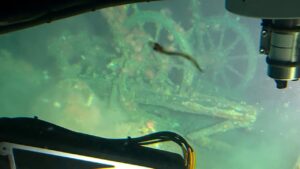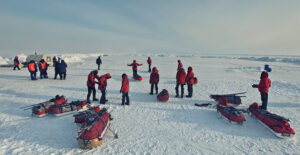Japanese explorer Yuki Sekiguchi is in his third winter of a four-year solo, human-powered traverse of northern Canada from Winnipeg, Manitoba to Resolute, Nunavut. His route crosses three major lakes — Lake Winnipeg, Great Slave Lake and Great Bear Lake — and includes long tundra sections and large parts of the Northwest Passage.

Stage 1, Lake Winnipeg. Photo: Yuki Sekiguchi
He started the project in 2017 with a 600km, 42-day manhaul across frozen Lake Winnipeg, from the southern tip at Selkirk, Manitoba to Norway House. He says he “simply felt curious” about Lake Winnipeg after hearing about a compatriot’s similar adventure there. He eventually decided that connecting three giant northern waterways would be even more interesting.
So Eventually, he added large sections of the Northwest Passage as “a beautiful adventure line”.
The following winter, in 2018, he returned to Norway House. Rather than simply head due north toward Resolute, he made a big western swing toward Great Slave and Great Bear Lakes. He cycled 3,600km along roads and seasonal ice roads to Deline, a First Nations community on the shores of Great Bear Lake. He then flew back east to Yellowknife and walked 200km across the Great Slave Lake to Hay River.

Stage 2, across the subarctic. Photo: Yuki Sekiguchi
The winter of 2019 was a gap year for his project, but Sekiguchi has now flown to Canada and is making his way back to Deline. On February 1, he will begin hauling his sled 1,500km across Great Bear Lake, then over tundra and sea ice to Gjoa Haven, named for the Gjoa, the ship that Amundsen sailed during the first complete traverse of the Northwest Passage in 1903-06. Gjoa Haven is located on little King William Island, which is rife with tragedy as well as success: Here, Sir John Franklin’s two ships, the Erebus and the Terror, came to grief in the late 1840s.
Sekiguchi will resupply twice during his journey, roughly every 500km. Kugluktuk — formerly Coppermine — is his first stop. Kugluktuk is often considered the western end of the Northwest Passage. From here, he takes to the sea ice, skiing from the mainland across Amundsen Gulf to Victoria Island. He stops at Cambridge Bay for his second resupply. He’s particularly looking forward to Cambridge Bay, since the late Naomi Uemura, perhaps Japan’s most famous adventurer, passed through here on his 12,000km dogsled journey from Greenland to Alaska in 1976.
Reaching Gjoa Haven after an estimated 105 days, he will have to call a halt to this year’s trek. The sea ice — in particular, the last 70 or 80km the Resolute — won’t last long enough for him to complete the entire route this year.

Stage 3 route. Image: Yuki Sekiguchi
Sekiguchi prefers to travel simply — no Facebook or Instagram updates — but he has decided that it was too risky to strike out with no communication at all. So reluctantly, he will carry a satphone and SPOT device, but he insists that he will “only use them if requesting a rescue, not for any other purpose”.
He is still unsure if he will carry a firearm for polar bear protection during his last 1,000km on sea ice, where meeting the great bear is a distinct possibility.

Photo: Yuki Sekiguchi
If all goes well, next winter Sekiguchi will return to Gjoa Haven and wend his way to Resolute, the last stop of jets from the south and what he considers “the Mecca of polar adventure, visited by some of the leading adventurers of the past.”






